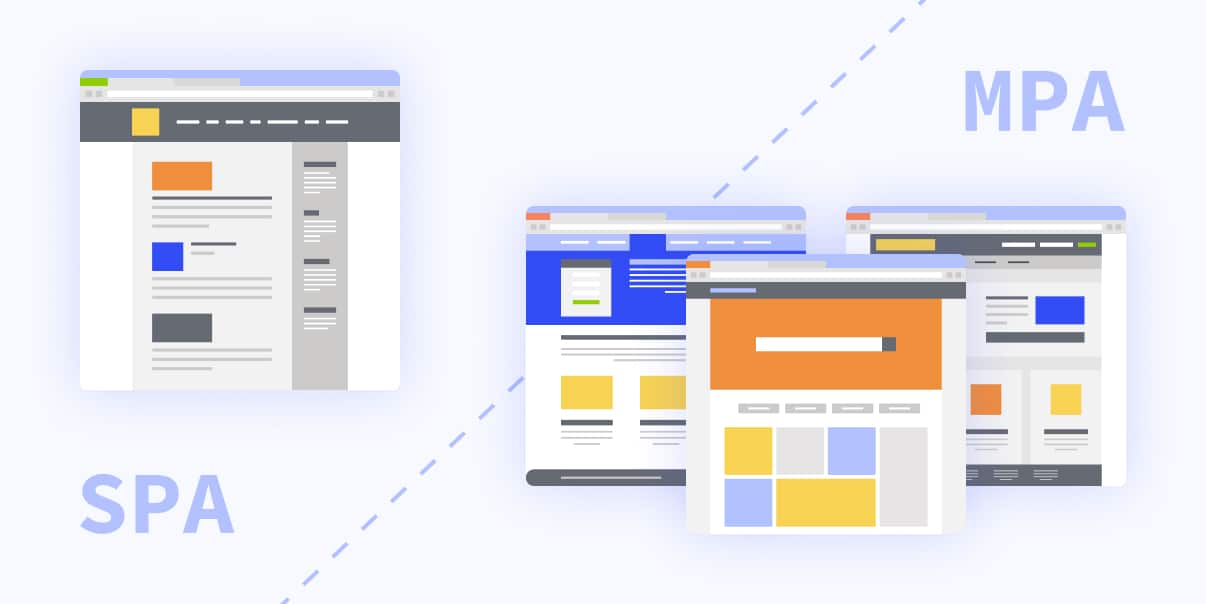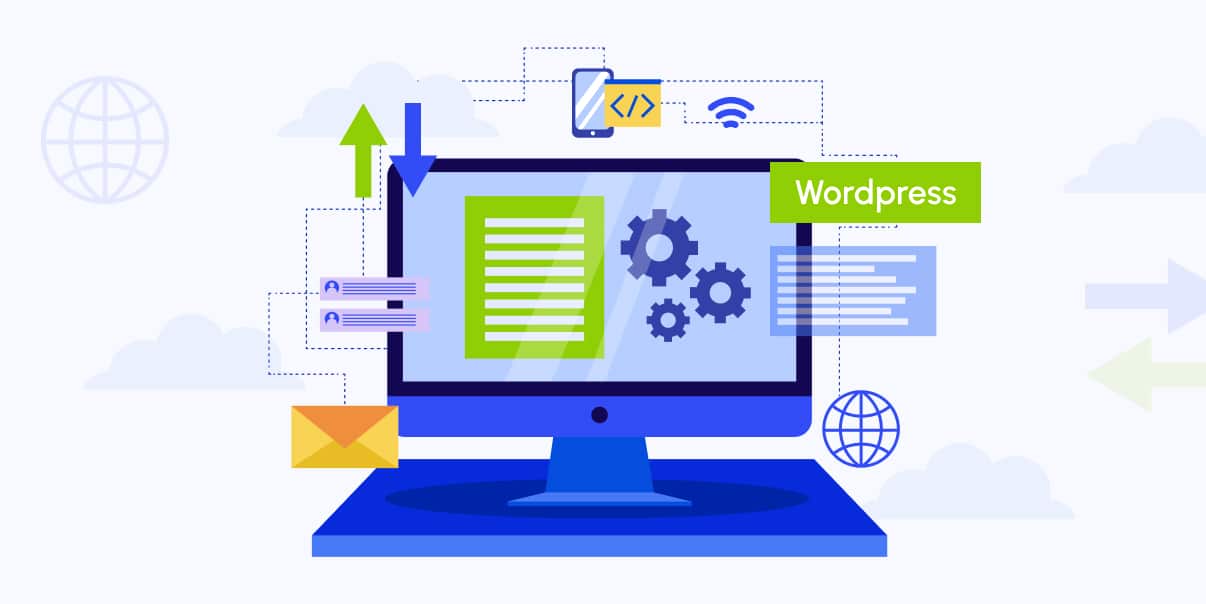Single-page Application vs. Multi-page Application
Understanding the Key Differences

The digital landscape has evolved, and web development projects have various architecture options. Among the popular choices are single-page applications (SPAs) and multi-page applications (MPAs). Choosing the right architecture is crucial for the success of your project. Your choice would affect user experience, performance, and maintainability.
This article will explore the differences between SPAs and MPAs. We’ll discuss their advantages and disadvantages and when to choose one. We’ll also touch upon hybrid approaches that combine the best of both worlds.
Understanding Single-page Applications (SPAs)
Single-page apps (SPAs) are web apps that load a single page and dynamically update content as users interact. The users don’t need to reload the whole webpage when they click a link or button. A single-page application uses JavaScript to handle user interactions. This type of architecture provides a smooth user experience, similar to a desktop or mobile applications.
Advantages of Single-page Apps
Single-page applications (SPAs) offer several benefits. Let’s dive into these advantages and see how they benefit your web development projects.
- Faster Loading
Since SPAs only need to load a single HTML page, they can be faster than traditional websites. You can navigate and interact with the app more quickly, making for a smoother experience.
- Seamless Navigation
With SPAs, you can move between different website sections without waiting for a new page to load. You can create a more seamless and enjoyable browsing experience. A single-page application is similar to a native app on your phone.
- Less Data Usage
Because SPAs only load the data needed for the specific section you’re viewing, they can use fewer data than a traditional web application. They are beneficial if you’re on a limited data plan or have a slow internet connection.
- Offline Support
SPAs can work even when you don’t have an internet connection, thanks to “caching.” Caching means the app stores the needed data on your device, so you can still access and use it when you’re offline.
- Easier to Update
With a SPA, developers only need to modify a single HTML page. They can add improvements and new features quickly, keeping the app up-to-date.
- Consistent Look and Feel
Since SPAs use a single HTML page, they have a consistent look and feel throughout the app. A consistent look makes the app look more professional and more user-friendly.
Disadvantages of SPAs
Single-page apps (SPAs) have some downsides, even though they can be fast and user-friendly. Here are some disadvantages to consider when deciding whether to use a single-page app:
- SEO Challenges
SPAs can make it harder for search engines, like Google, to find and understand the content on your website. Search engines usually look at different pages, but SPAs have just one. The structure of a single-page application can make it harder for your website to appear in search results.
- Initial Loading Time
While SPAs can be fast once loaded, they can take longer to load the first time you visit the website. The app has to load all the necessary data and resources at once. A long initial loading time might cause users to leave if they don’t want to wait.
- Complex Development
Building a single-page application can be more complicated than building a traditional website. Developers have to think about how the app will work offline, manage data efficiently, and make sure the app works well on different devices.
- Browser Compatibility
Not all web browsers support the features needed for SPAs to work correctly. Older browsers or browsers with specific settings might be unable to use the app.
- Poor Accessibility
Single-page applications can be more challenging for people with disabilities because a web app runs in JavaScript. Some assistive technologies, like screen readers, have trouble working with JavaScript.
- Memory Usage
Single-page applications can use more memory on your device than traditional websites. These apps must store data and resources for the entire app rather than just individual pages. If your device has limited memory, this can cause problems.
Understanding Multi-page Applications (MPAs)
Multi-page apps (MPAs) are websites with multiple web pages connected through links.
Advantages of Multi-page Applications
They offer several advantages that can make them an excellent choice for specific projects. Let’s discuss some of these advantages:
- Familiarity
Many people are used to the traditional way of browsing websites with multiple pages. MPAs offer a familiar navigation experience, making it easy for users to understand and use the website.
- Better Organization
MPAs allow you to divide content into separate pages, making it easier to organize information. An organized app can help users quickly find what they’re looking for.
- Easier SEO
SEO, or Search Engine Optimization, helps your website appear on search engines like Google. With MPAs, optimizing each page for specific keywords is often easier. An optimized web page makes your website more visible to people searching for relevant topics.
- Improved Analytics
MPAs make tracking user behavior and engagement easier since each page can be analyzed individually. Improved analytics can help you understand which pages are popular and which need improvement.
- Faster Loading Times
MPAs often load faster than single-page apps because they only need to load the current page’s content, not the entire website. Fast loading can lead to a better user experience, especially for users with slow internet connections.
- Simpler Updates
With MPAs, you can update specific pages without affecting the entire website. Adding new content or making changes is easier as it won’t disrupt the user experience.
Disadvantages of MPAs
Multi-page apps (MPAs) also have some disadvantages that can make them less suitable for specific projects. Let’s discuss some of these drawbacks:
- More Complex Navigation
Since multi-page applications have multiple pages, users need to click on links to move between them. Navigating MPAs can be complicated, especially for large websites with many pages.
- Slower Transitions
When users click a link in a multi-page application, the browser has to load a new page. Loading a new page cause slower transitions between pages than single-page apps.
- More Maintenance
Multi-page applications require maintenance because they have multiple pages and separate files. With MPAs, managing and updating the website will be more complex, especially if it grows over time.
- Inconsistent User Experience
With MPAs, users may experience inconsistent designs and user interfaces across different pages. Inconsistency can lead to confusion and a less enjoyable browsing experience.
- Less Mobile-friendly
Many MPAs are not optimized for mobile devices, making them difficult to navigate on smaller screens.
- Fewer Interactive Features
MPAs typically offer fewer interactive features compared to single-page apps. Fewer features can make them less engaging and dynamic, which could be a drawback for some users.
Key Differences between SPAs and MPAs
SPAs and MPAs are different ways to build websites. They each have unique features, which can be helpful in different situations. Let’s look at the critical differences between them.
Loading and Navigation
In a single-page application, the entire web page loads just once. After that, only the content changes when you navigate to different sections.
In a multi-page application, the entire web page reloads whenever you visit a new section. As a result, navigating a multi-page application may feel slower.
Development Complexity
Creating a single-page application can be more complex. It often requires advanced programming skills and a deeper understanding of JavaScript frameworks.
Creating a multi-page application is generally more straightforward. It typically uses traditional HTML, CSS, and basic JavaScript.
Search Engine Optimization (SEO)
Since single-page applications load content dynamically. Search engines might have difficulty crawling and indexing the website. SPAs can make it more challenging to achieve a high search ranking.
MPAs have better SEO performance, as each page is a separate HTML file, making it easier for search engines to crawl and index the content.
User Experience
SPAs offer an excellent user experience with quick navigation and smooth transitions. A single-page app often feels more like a mobile app.
Although MPAs can offer a good user experience, they may not feel as seamless as SPAs because of page reloads.
Data Handling
SPAs use APIs (Application Programming Interfaces) to communicate with the server. Using APIs allows for efficient data exchange and can reduce the load on the server.
In MPAs, data handling often relies on traditional server-side rendering. It can result in more server requests and increased load times.
Security Considerations
SPAs can be more vulnerable to security threats like cross-site scripting (XSS) attacks. They rely heavily on JavaScript, which malicious actors can exploit. Developers must be diligent in implementing proper security measures to prevent such attacks.
In multi-page applications, security threats like cross-site scripting can also exist. However, since MPAs rely more on backend code, they may be less susceptible to client-side vulnerabilities. Nevertheless, developers should still prioritize security when building MPAs.
Integration with Third-Party Services
SPAs can easily integrate with third-party services like Google Analytics and Google Maps through APIs. This integration allows for a seamless and interactive experience for users. It also results in more accurate tracking of user behavior and engagement.
MPAs can also integrate with third-party services like Google Analytics and Google Maps. However, the integration may be less seamless as each page must load the required scripts and resources separately.
Use Cases: When to Choose SPA or MPA
Best Use Cases for SPAs
SPAs can be beneficial in certain situations. Here are some of the best use cases for SPAs:
Fast and Responsive Websites
SPAs are fast and responsive because they don’t reload the entire page when you click on something. This feature is great for websites where users must navigate quickly and smoothly.
Mobile Applications
SPAs work well on mobile devices because they use less data and load faster than traditional websites. They can provide a more app-like experience for users, making it easier to use on smartphones and tablets.
Dynamic Content
A single-page app is a good choice for websites with frequently changing content or real-time updates. It can quickly display new information without having to reload the page.
Interactive Features
SPAs are great for websites with interactive features like games, quizzes, or surveys. Users can enjoy these activities without waiting for the page to load each time they make a move.
Simplified Development
SPAs can be easier to build and maintain for developers. These apps often use fewer resources and have a more straightforward structure. You can spend less time developing and creating a more efficient final product.
Best Use Cases for MPAs
MPAs have been around for a long time and can be an excellent choice for specific situations. Here are some of the best use cases for MPAs:
Large Websites
MPAs are ideal for big websites with much content, like online stores, news websites, or educational platforms. These websites often have many sections and categories. Using separate pages makes organizing and managing all the content easier.
Search Engine Optimization (SEO)
MPAs can be better for SEO because each page has its unique URL, title, and metadata. Search engines can find and index content quickly, which can help improve the website’s ranking in search results.
Easier Navigation
MPAs can be easier to navigate for users unfamiliar with modern web applications. They can use their browser’s traditional back and forward buttons to move between pages, which can be more intuitive for some people.
Progressive Loading
With MPAs, only the content on the current page loads. Users can save bandwidth and load the website faster. Progressive loading improves the user experience and makes the website more accessible.
Compatibility
MPAs can be more compatible with older web browsers and devices. They don’t rely on advanced technologies like JavaScript as much as single-page applications. Compatibility is essential if your target audience includes users with older devices or browsers.
Hybrid Approaches: Combining SPA and MPA
A hybrid approach combines the best parts of SPAs and MPAs. Like a single-page application, you can create a website that feels fast and smooth. Plus, your app can also have the structure and flexibility of an MPA. The hybrid approach can be an excellent solution for many types of websites.
One of the primary reasons to use a hybrid approach is to optimize the app for both online and offline mode. When you use local data efficiently, your app can provide a smooth user experience even when the internet connection is unstable.
Benefits of a Hybrid Approach
Here are the benefits you can get when using the hybrid approach.
- Speed
Combining SPA and MPA techniques can make your website load faster. You can use the SPA technique on some parts of the website, making those parts feel quicker and more responsive.
- Flexibility
A hybrid approach lets you choose which parts of your website should be single or more than one page. This approach helps you create a website that works well for your needs.
- SEO
A hybrid approach can be better for SEO because it can make it easier for search engines to understand your website.
- Ease of Development
Developing a hybrid website can be easier than building SPAs or MPAs. With this approach, you can use the best parts of both techniques to create a website that works well for your needs.
Use Cases for Hybrid Approach
Here are several use cases for the hybrid approach.
- E-commerce Websites
Online stores can benefit from a hybrid approach. It can make the shopping experience smoother and faster. Plus, it allows for a well-organized website with many different products and categories.
- Blogs and News Websites
These types of websites often have lots of articles and pages. A hybrid approach can make finding and reading articles easier without waiting for new pages to load.
- Social Media Platforms
Websites like Facebook and Twitter can benefit from a hybrid approach for faster and more interactive platforms. This approach can help keep users engaged.
Conclusion
In summary, understanding the differences between single-page and multi-page applications is crucial. It will help you choose the right architecture for your web development project.
While SPAs offer better user experience and quicker loading times, MPAs excel in SEO and scalability. Consider your project’s specific needs, and weigh the advantages and disadvantages before deciding.
Also, explore hybrid solutions combining the best of both worlds. For further guidance and expert assistance, contact BIT Studios for all your web development needs.
We’re BIT Studios!
At BIT Studios we specialize in designing, building, shipping, and scaling beautiful, usable products with blazing-fast efficiency



